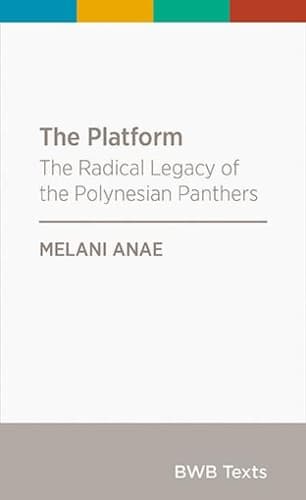Review: The Platform: The Radical Legacy of the Polynesian Panthers
Reviewed by Kristoffer Lavasii
Melani Anae’s The Platform: The Radical Legacy of the Polynesian Panthers may appear on the face of it to be just a book but it is far more than that. In her own words, it is a malu formed in steel-ink that inscribes into the flesh of the author, and the mind of the reader, the interconnected the story of herself, the Polynesian Panthers and the journey that the first generation of New Zealand born Pasifika people faced.
The Platform opens with an interesting question posed by Anae herself: “Did the PPP platform drive my life’s work or did my life experiences drive the three-point platform and the continuing work of the PPP? Is there a difference?”
As her story unfolds, the question reflects the key focus of The Platform, the way in which the life of the woman and the life of the revolutionary bore no clear demarcation and yet are inextricably linked – as much a part of each other as they are distinct.
Framed within her own story, we see the backdrop of racism, both apparent and systemic, that sat, and continues to sit, behind the veneer of New Zealand society. We see the issues that informed her upbringing as Samoan born in another land, the way these challenges would inform her worldview and would bring her into contact with others who shared these distinct challenges – an entire generation of New Zealand born Pasifika people who would become the vanguard of Pacific people in Aotearoa New Zealand.
Anae weaves the tales of the people behind the Party, who are the Party. Of the strong and charismatic leaders but also of the many members, named and unnamed, whose simple act of support and participation was in itself a consummate act of revolution. She notes the Dawn Raids – an oft neglected piece of New Zealand history and how it revealed the seething racism manifest in many New Zealanders. But as much as it was a time of trial, prejudice and blatant racism, it was also a crucible that the steel of the Polynesian Panthers was fired in and refined. Through the experiences of Anae and her brothers and sisters, we see the paradox that she brings to our attention, the mutuality of the platform and the experience. They inform each other and form each other.
A casual reader expecting a simplistic tale of events and dates is a victim of the warnings in this book.
Anae gives lessons, both in practice and in theory, that illustrate the latter three-point Polynesian Panther platform: of peaceful resistance against all forms of racism, Pacific empowerment and educate to liberate. In these expressions we see the heart of the Polynesian Panthers and the central tenets to Anae and her fellows. A commitment to challenging discrimination, to empowering their communities and educating these communities and the wider public so as to enable them to challenge, to fight and to lead themselves. In the crafting of her malu, these three motifs repeat – in black and in white, in contrast and in full fleshed colour, reversed and inversed, applied and countered.
A casual reader expecting a simplistic tale of events and dates is a victim of the warnings in this book. This is history as only Pacific people would understand. For it is people, not the events, that mark the annals of history – this is not the voiceless accounts but a fully fleshed experience of the times of the Dawn Raids and the first formal movements of the Polynesian Panthers. And yet it is not about the Panthers. Much as this is a history that is not a history, the object of this malu is not a mere movement.
It is about ideologies, aspirations and hopes. In the subtitle Anae notes that the true intention of the book lies in the legacy of the Panthers. In this way it is much like a malu. The malu is both an entity unto itself and a representation. When one is inscribed in ink, one is tying oneself to Samoa, to its people, to its history, to its present and to its future. A malu is a representation, a story of the one who wears it and a commitment to who it is tied to. This malu is the same. It is the translation of history; it is a message for the present and a tie into the future. The malu that Anae bears is an inheritance for her people, for her communities and those who will go on after.
This malu of steel-ink shines in its glory, a beacon and warning both. A warning to those who would be content to ignore its message and an invitation for those who desire to know. This book is a challenge to the next generation, a reminder of the interconnectedness that informs our existence, that ties all Pacific people in the va. The question that Anae first asks is not necessarily answered but those who read The Platform will walk away changed, educated and ready to ask this question of themselves.
Reviewed by Kristoffer Lavasi’i
